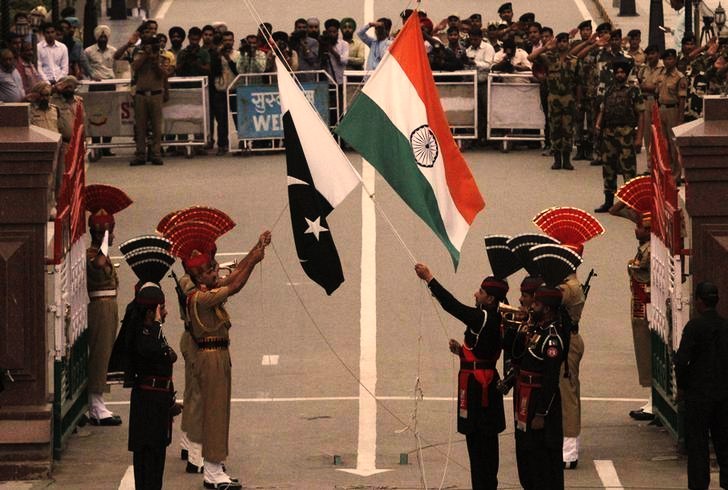Chandigarh: India’s plans to further increase the height of the flagpole flying the tri-colour at the Attari-Wagah border crossing with Pakistan, to dwarf its neighbour’s flag, is yet another instance of the two nuclear rivals’ quest in relentlessly competing with the other to demonstrate superiority.
Media reports recently revealed that India aimed to increase the height of its flagpole at the only land crossing between the neighbouring countries from 360 feet at present to 410 feet, with the purpose of dwarfing the taller, adjacent Pakistani Parcham-e-Sitarah-o-Hilal, flying atop a 400 feet high mast.
This deliberate one-upmanship is expected to occur imminently, ahead of the restarting of the hugely popular Beating Retreat ceremony at Wagah at sunset, which was suspended in March 2020 after the coronavirus pandemic outbreak.
This flagpole-centered competition at Wagah – that began in 2017 after India erected it at a cost of Rs 3.5 crore – also involves the flag size, which in keeping with the puerile contestation, too has to be bigger than its rivals. But the flag has caused India much embarrassment as it had to be replaced three times soon after it was first hoisted after it was badly torn by blistering winds in the area, an aspect the authorities had earlier failed to consider.
In keeping with Indian law, a damaged flag cannot be flown and needs to be immediately replaced. And since each flag at the time cost around Rs 1.63 lakh, erecting four in succession ended up being an expensive prospect, totalling around Rs 6.50 lakh.
The Attari-Wagah flagpole rivalry, however, is yet another palpable manifestation of the mutual one-upmanship contest between New Delhi and Islamabad, which extends beyond military stand-offs, cross-border terrorism, diplomatic demarches and all-round bellicosity, into the daily lives of people on both sides of their volatile border.
Beyond military rivalry
This comical competitiveness stretches beyond duelling each other on the regional and global strategic chessboard, conducting tit-for-tat underground nuclear tests, acquiring better materiel and engaging in military and political comeuppances, to ordinary, everyday matters.
Each country’s people, for instance, vociferously claim to grow sweeter mangoes, melons and grapes than the other, produce better music, singers and television programmes, and even entertain and dress better and keep a more lavish table than those across the border.
Pakistanis are convinced – some believe with demonstrable justification – that their men and women are more attractive and better-looking than their Indian counterparts, brimming with suavity, chutzpah and style. Conveniently, however, many Pakistanis decline to state that most of their high-end shopping for chic ethnic clothing, jewellery and associated baubles, especially ahead of weddings, which augment their overall aura, actually come from India.
Several Pakistanis are also firmly of the view – and say as much loudly for anybody that cares to listen – that poverty in India is glaringly more visible than in their country and that their neighbours are less generous, hospitable and gregarious than them. They too pride themselves on a keener sense of humour and irreverence, higher intellect and finer sense of tehzeeb or etiquette than most Indians.
But both sides believe that their sporting prowess in cricket and hockey, which India and Pakistan had played with dexterity as one before independence from British Colonial rule 73 years ago, is superior to the other. Similar sentiments apply to esoteric games like polo and equestrian sports like tent-pegging and show jumping.
Cricket matches between the neighbours are particularly tense events, almost mirroring their military rivalry, as the losing side faces the ire of millions of fans in either country. Over years, this has often turned nasty for the losing team returning home, especially in Pakistan. The victorious cricketing or hockey side, on the other hand, is lauded and lavished with accolades and financial rewards for having bested the ‘enemy’.

Representative image. Fans in Kolkata watching the India-Pakistan match.
“The uncomplicated reality is that the rivalry between Indians and Pakistanis arises not so much from being different, but from being somewhat similar,” said an Indian diplomat posted in Islamabad in the 1990s, This, in turn, he conceded, declining to be named, locked them both into an unending competitive cycle to outdo one another in all spheres in order to feel superior; but more importantly to make the other side feel like lesser beings.
India’s late foreign, defence and finance minister Jaswant Singh of the Hindu nationalist Bhartiya Janata Party too felt similarly, declaring that both countries shared a common heritage which they went to great lengths to deny for political, nationalistic and religious reasons. “India, Pakistan (and Bangladesh) are from the same womb,” he had stated some years ago, adding that they had an ‘intrinsic’ bonding at a time when such sentiments were considered ‘acceptable’ to voice.
However, one domain in which most Pakistanis willingly, but grudgingly, accept Indian supremacy is Bollywood, the world’s largest movie bazaar. They reluctantly acknowledge that Lollywood, Pakistan’s nascent film industry, based out of Lahore that gives it its name, is what it really is: a deprived Bollywood imitation.
But not to be cowed, they reassure themselves by pointing out that, for decades, a majority of Bollywood icons have been Muslims like the recently deceased Yusuf Khan, better known as Dilip Kumar, Shah Rukh Khan, Salman Khan, Amjad Khan and Aamir Khan. Muslim Bollywood actresses like Katrina Kaif and Shabana Azmi too are household names in Pakistan, with most of their box office hits in that country.
The flagpole competition
Meanwhile, the aggressive competition between India and Pakistan showcases itself conspicuously at Wagah, where the flagpole competition is looming, when impeccably turned-out border guards lower their respective flags daily at sunset.
Specially trained Border Security Force or BSF personnel, selected for their height, fierce moustaches and military bearing, and similarly recruited but salwar-and-kameez sporting Pakistan Rangers, try and outdo one another in marching, pirouetting and screaming ear-splitting commands, as they go about their flag lowering.
The spectacular theatrics that take place in amphitheatre-like surroundings, backed by robust commentary from accomplished compères and patriotic songs, are lustily cheered by thousands of spectators on either side of the frontier. Over the years, these daily performances for which tickets are sold, have become hugely popular, and are rated highly on the tourist circuit in both countries.
After the border gates are shut at sunset, Pakistani and Indian nationals, separated by a few hundred yards of no-man’s land, shout out to each other, extolling the performance of their border guards as well as their overall superiority.
At times this desire for one-upmanship reaches ridiculous, and often wily, but sardonic heights.During the 2001 bilateral summit at Agra, former Pakistan President Pervez Musharraf, for instance, was assigned, in keeping with protocol, an unusually tall Indian Air Force (IAF) officer as his ceremonial aide-de-camp. The Indian motive was simple but crafty: it would compel the visiting enemy leader and that too a soldier, to look up to the IAF man every time they spoke.
In all likelihood, the put-downer irony was not wasted on Musharraf who departed Agra in a huff.
































